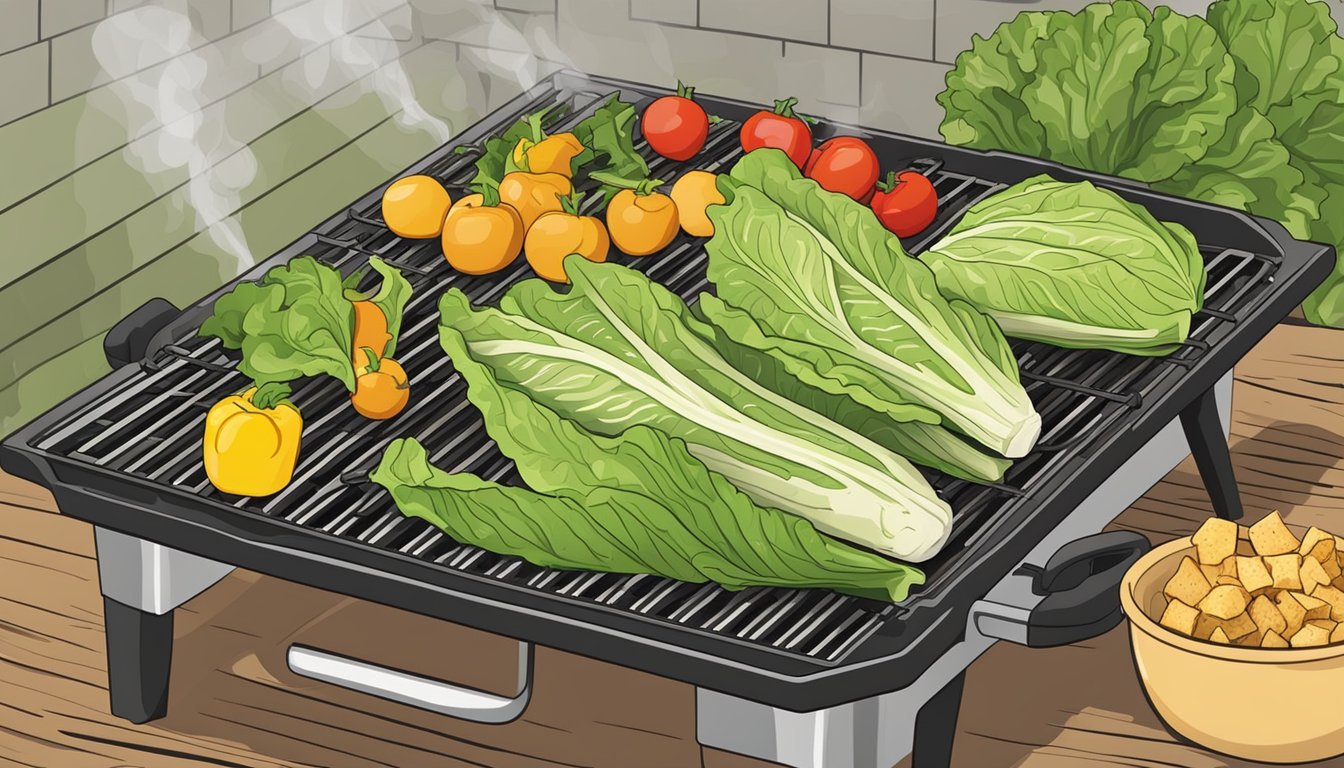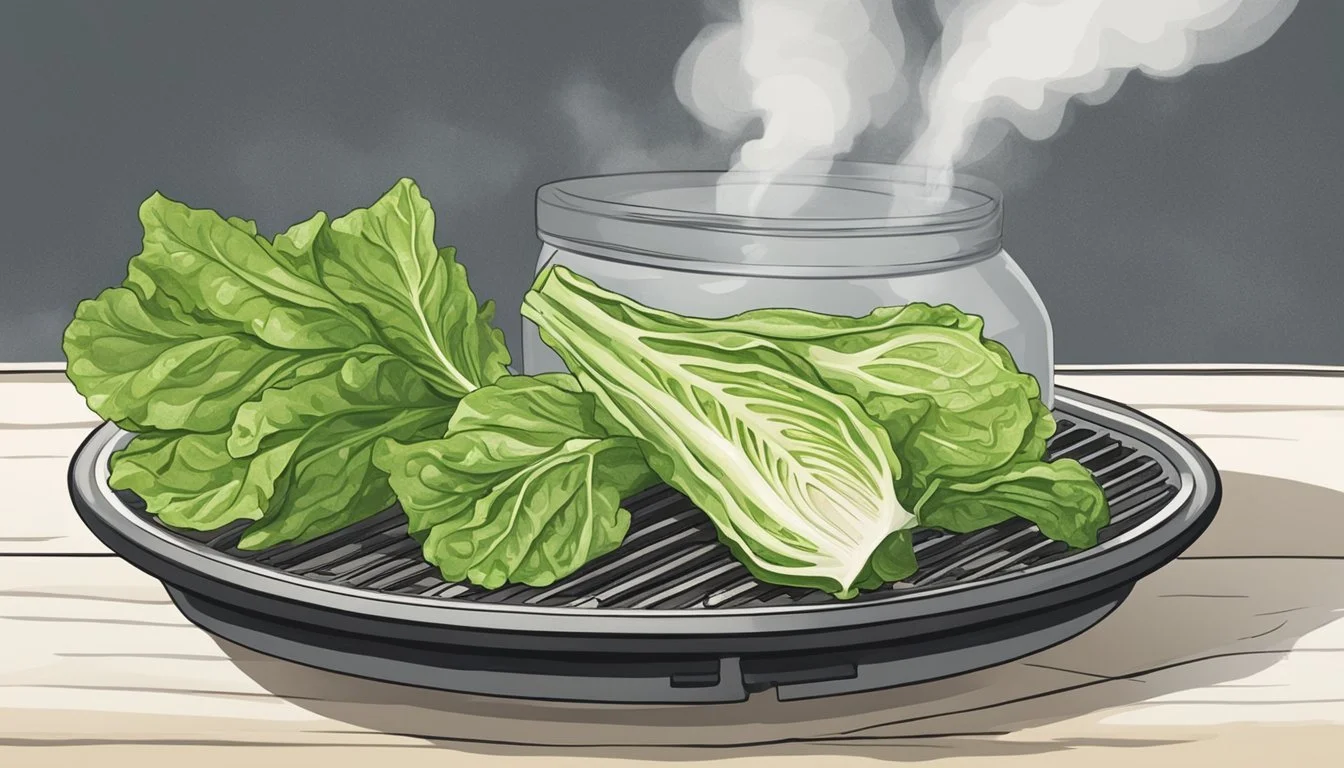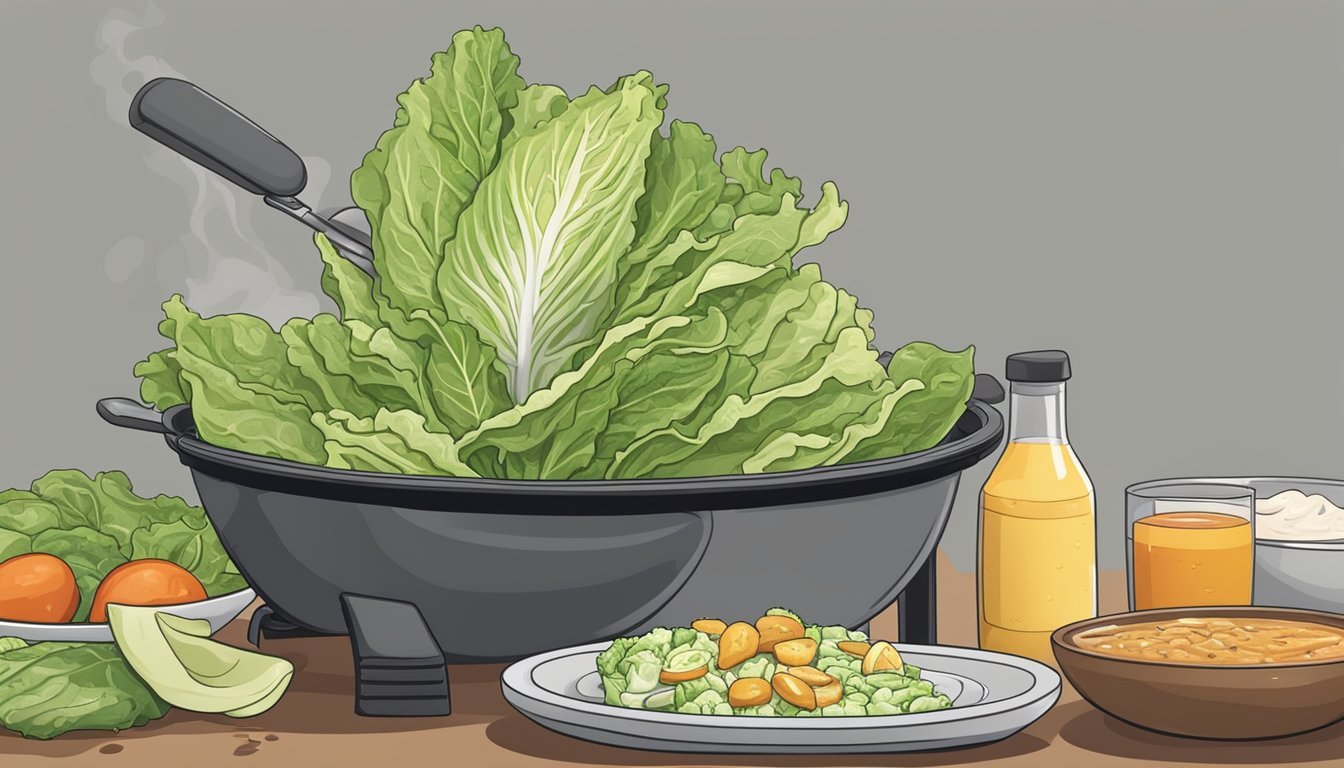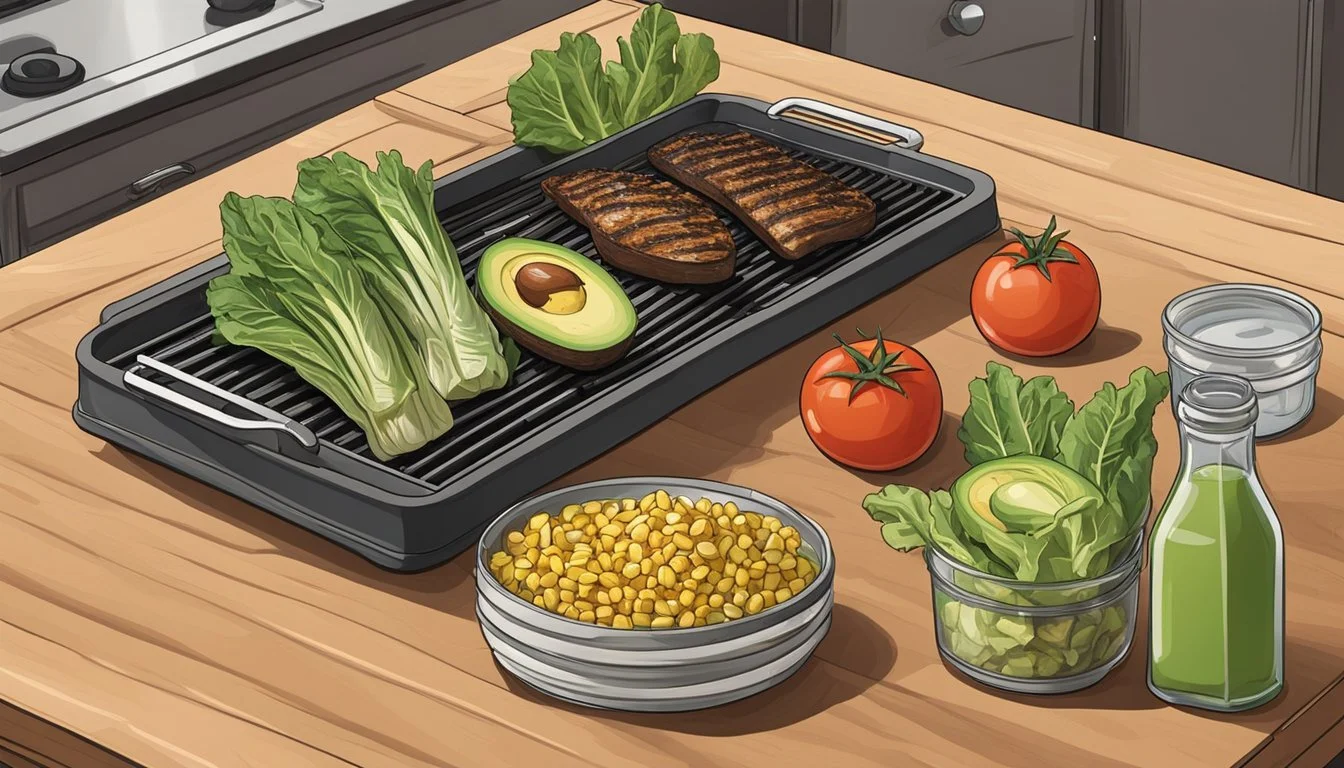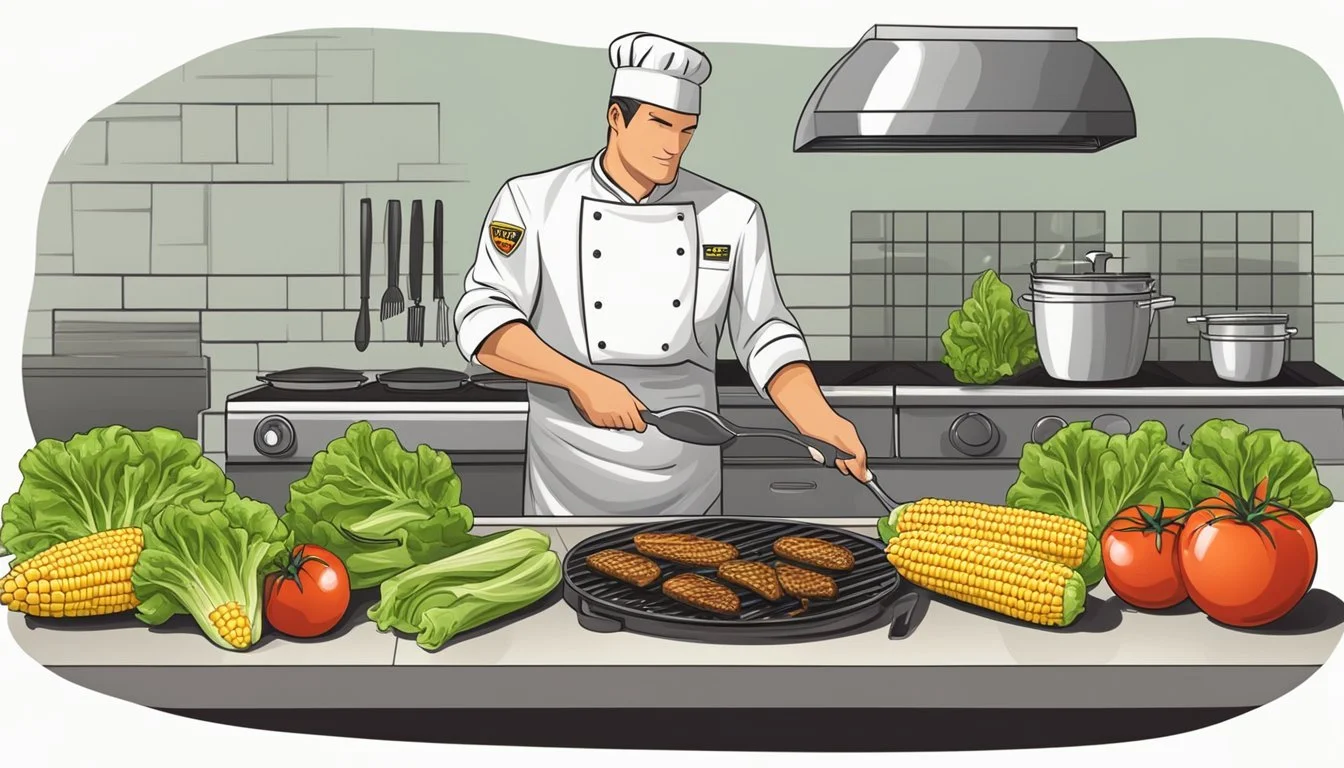How to Make a Texas-Style Grilled Romaine Salad
Your Ultimate Guide
Grilling romaine lettuce introduces a smoky flavor and crisp texture that forms the perfect base for a Texas-style salad. This culinary technique transforms the humble green into a charred, delectable delight. By incorporating traditional Texas flavors such as spicy barbecue rubs, tangy dressings, and hearty toppings like crisp bacon or roasted corn, this salad offers a bold twist on the conventional garden variety.
Preparing a Texas-style grilled romaine salad involves simplicity and precision. The romaine hearts are sliced and brushed with olive oil, then seasoned with a blend of spices resonant of the Southwestern palate before being placed on a hot grill. The high heat chars the outer leaves while maintaining a crisp, refreshing crunch at the heart. The final touch is a generous drizzle of ranch dressing infused with jalapeño, adding a creamy yet fiery complement to the robust flavors of the grill.
Assembling the salad is an opportunity to showcase creativity and preference. Toppings like black beans, cherry tomatoes, diced avocado, and shredded cheddar cheese contribute both texture and taste, turning the dish into a substantial meal. The interplay of smoky, spicy, and creamy elements not only caters to the adventurous eater but also pays homage to the Texan spirit, where food is not just nourishment but an experience to be savored.
Getting Started With Ingredients
The foundation of a Texas-Style Grilled Romaine Salad lies in choosing fresh, high-quality ingredients that would blend to create a robust, Texan flair. Selecting the right type, freshness, and preparing them to maximize their flavors are vital steps in the process.
Selection of Romaine Lettuce
For the base of this salad, one should select romaine lettuce that is crisp and free of blemishes. The leaves should be dark green, indicating they are mature and flavorful.
Criteria: Firm stalks, crisp leaves, no dark or slimy spots
Quantity: Typically one large head per salad serving
Choosing Salad Proteins
Traditionally, grilled chicken is the protein of choice to complement a Texas-Style Salad's robust flavors. Opt for boneless, skinless chicken breasts (What wine goes well with chicken breast?) or thighs marinated in Texan spices.
Protein Options:
Chicken breast or thighs
Preparation: Marinate with spices like cumin, garlic powder, and chili powder
Additional Salad Vegetables
No Texas-Style salad is complete without a colorful medley of vegetables. They should be fresh, and diced or sliced to a bite-size consistency.
Vegetable Additions:
Tomatoes: Fresh, ripe, diced
Avocado: Sliced for a creamy texture
Onions: Red or green onions, finely chopped
Corn: Grilled for a smoky flavor
Cucumber: Sliced for crunch
Radishes: Thinly sliced for peppery notes
Preparing the Dressing Ingredients
A zesty dressing ties the salad together. Gather fresh lemons, quality olive oil, Dijon mustard, and season with salt and black pepper to taste.
Dressing Base:
Olive oil: Extra-virgin preferred
Lemon juice: Freshly squeezed
Seasonings:
Dijon mustard: For tanginess
Garlic powder: Optionally for more depth
Salt and pepper: Always freshly ground for best flavor
Cooking Techniques
Perfecting a Texas-style grilled romaine salad involves mastering a few important cooking techniques. From the smoky char on the lettuce to the impeccably cooked proteins, each element contributes to a vibrant and robust dish.
Grilling the Romaine
Grilling romaine lettuce transforms it from a simple salad base to a flavorful component. The key is to preheat the grill to medium-high and lightly brush the cut sides of the romaine hearts with olive oil. The romaine should be placed cut side down on the grill and cooked for about 3 to 4 minutes until it achieves a slight char. Then, flip each piece and grill for an additional minute to ensure an even smokiness.
Cooking Additional Proteins
For a complete meal, adding proteins such as steak or grilled chicken is essential. To achieve a flavorful crust on the steak, one should allow it to reach room temperature and pat it dry before seasoning with salt and pepper. It’s best to cook over high heat for a time that aligns with the desired doneness. Chicken should be marinated in a blend of spices to infuse it with Texas-style flavors and then grilled over medium-high heat until the internal temperature reaches 165 degrees F, ensuring the chicken is thoroughly cooked without being dry.
Steak: 3-5 minutes per side, depending on thickness and desired doneness.
Chicken: 6-8 minutes per side, ensuring internal temperature is safe.
Preparing Grilling Equipment
Before cooking, one must ensure that grilling equipment is ready for use. Grates should be cleaned to prevent sticking and impart clean grill marks on the food. It's advisable to oil the grates with a high smoke point fat such as canola oil. One should preheat the grill to the appropriate temperature before placing any food on it. For a charcoal grill, wait until the coals are covered with white ash; for a gas grill, preheating should take about 10 minutes.
Assembling the Salad
Crafting a Texas-style grilled romaine salad involves a meticulous assembly of fresh greens, an assortment of proteins and toppings, and the finishing touch of a complementary dressing. Each component comes together to create a harmonious balance of textures and flavors.
Cutting and Arranging Greens
One begins by washing the romaine lettuce thoroughly, then cutting the heads in half lengthwise to expose the inner leaves. This cut maximizes the greens' surface area for grilling, which is crucial for achieving that coveted smoky char without overcooking. They are then arranged on a clean grill, slightly oiled to prevent sticking, and cooked until crisp edges appear, maintaining their crunch.
Adding Proteins and Toppings
After the greens have been grilled, they're ready to be topped with proteins and additional fixings. Crispy bacon, cooked until nirvana is achieved and then crumbled, brings a smoky depth. Tender pieces of rotisserie chicken add substantial protein. Black beans can be sprinkled on for a fiber-rich addition. Handmade croutons, preferably toasted with garlic and butter, add a necessary crunch. One should distribute these toppings evenly to ensure each bite is flavorful.
Toppings Quantity Notes Bacon 3-4 strips Crumbled, for a smoky crunch Black Beans 1/4 cup Rinsed and drained Croutons 1/2 cup Garlic and butter flavored, for crunch Rotisserie Chicken 1 cup Shredded or chopped
Finishing with Dressing
To conclude the assembly, the salad is drizzled with a robust Texas-style dressing – often a smoky chipotle or ranch variety that complements the grilled lettuce's charred notes. A sprinkle of shredded cheese, such as sharp cheddar or a Mexican cheese blend, enriches the ensemble. The dressing should be applied with a light hand to not overpower the salad's fresh and grilled elements.
Perfect Your Salad Dressing
Creating the ideal dressing for a Texas-style grilled romaine salad involves understanding the delicate balance of flavors and the technique of emulsification. The dressing should complement the smokiness of the grilled lettuce while infusing the dish with a bold Texas flair.
Emulsifying Fat and Acid
For a well-emulsified dressing, one must vigorously combine fat and acid to create a stable blend. The typical base of fat, such as olive oil, should be whisked with an acid like apple cider vinegar or lemon juice until the mixture is unified and thickened. One can also add mayonnaise to aid in the emulsification process, providing a creamy consistency.
Ingredients for Emulsification:
Fat: Olive oil
Acid: Apple cider vinegar or lemon juice
Emulsifier: Mayonnaise (optional)
Balancing Flavors and Seasoning
Achieving the right flavor balance is critical. Start with a base of olive oil and vinegar or lemon juice for tanginess, then incorporate sweetness with a bit of honey to counteract the acidity. Seasoning with salt is crucial for enhancing the overall taste, while a pinch of sugar can solve excessive tartness. For a true Texas-Style salad, one might consider a bold blue cheese dressing or a tangy ranch dressing with a hint of heat.
Flavor Balance Checklist:
Sweet: Honey
Salt: Kosher or sea salt
Heat: Add a dash of hot sauce or cayenne pepper
Herbs: Fresh local herbs for depth
Homemade vs. Store-bought Dressing
Homemade dressings are typically fresher and customizable. One has control over the quality of ingredients, like opting for high-quality olive oil and fresh lemon juice, resulting in a more flavorful dressing without preservatives. Conversely, store-bought dressings can offer convenience and consistency, although they may contain additives and tend not to match the freshness of homemade versions.
Homemade Advantages:
Freshness: No preservatives, made with fresh ingredients
Customization: Adjust flavors to personal preference
Store-Bought Advantages:
Convenience: Pre-made and ready to use
Consistency: Uniform flavor and thickness
Serving and Presentation
The essence of serving a Texas-Style Grilled Romaine Salad lies in the visual appeal and complementing flavors that mark it as a standout dish. From the way it is plated to the sides and beverages it is paired with, each aspect enhances the overall experience.
Plating Your Grilled Salad
The grilled romaine should be served immediately while it's warm. It is typically laid on a plate cut-side up, showcasing the charred marks for visual appeal. For a classic Texas steakhouse filet salad, one might place thinly sliced steak atop the grilled lettuce, dressing it with a bold, savory vinaigrette or barbecue sauce to embrace the Texan flair.
Pairing with Sides or Beverages
A robust Texas-style salad pairs well with traditional sides such as:
Cornbread: A slice adds a sweet, buttery texture.
Tacos: Complement with light fish or grilled chicken tacos for a complete meal.
Enchiladas: Offer a contrast of creamy and smoky flavors. (What wine goes well with smoky flavors?)
For beverages, an ice-cold beer or a glass of bold red wine like a Cabernet Sauvignon adds just the right touch to balance the smokiness of the grilled romaine.
Garnishing for Extra Flair
Garnishes should be applied with a light hand to maintain the integrity of the grilled romaine while adding a pop of color and flavor. Consider:
Crumbled cheese: Queso fresco or a sharp cheddar can add richness.
Fresh herbs: A sprinkle of cilantro or chives brings brightness to the dish.
Croutons: For an extra crunch, homemade croutons seasoned with Texan spices.
A well-dressed and thoughtfully garnished Texas-Style Grilled Romaine Salad converts the humble house salad into a dish that stands alone in both flavor and presentation.
Nutritional Information
When preparing a Texas-style grilled romaine salad, it is important to be mindful of its nutritional components. This section provides an in-depth look at the calorie distribution, types of fats, sodium and sugar content, and the protein profile of the salad.
Calorie Content Breakdown
A standard serving of Texas-style grilled romaine salad typically contains between 150 to 300 calories. The variation depends on the addition of ingredients like dressing, cheese, and proteins like chicken or beef. The grilled romaine itself is low in calories, with most coming from the toppings and dressing.
Romaine Lettuce: Approx. 10 calories per cup (chopped)
Dressing: Approx. 70-100 calories per tablespoon
Cheese: Approx. 100 calories per ounce
Grilled Chicken/Beef (optional): Approx. 200 calories per 3-ounce serving
Understanding Fats and Cholesterol
The fats in a Texas-style grilled romaine salad can be controlled by the choice of dressing and the amount of cheese used. Aiming for healthy fats such as those from olive oil is beneficial.
Olive Oil: 14g of fat per tablespoon (2g saturated fat, 0g cholesterol)
Cheese: Varies in fat and saturated fat content, moderate use recommended
Avocado (optional): High in monounsaturated fats, which are healthier for the heart
Balancing Sodium and Sugars
Salad dressings and cheeses can contribute to the sodium levels in the salad. It's recommended to opt for low-sodium cheeses and dressings or to make a homemade dressing to keep sodium levels in check.
Dressing: Sodium content varies, read labels for lower-sodium options
Cheese: Go for low-sodium versions if available
For individuals managing diabetes, monitoring sugar intake is crucial. Most of the sugars in this salad come from the dressing, so it is wise to choose dressings with no added sugars.
High-Protein Salad Options
Protein transforms the grilled romaine salad from a side dish to a satisfying meal. Including grilled chicken or beef can significantly increase the salad's protein content.
Grilled Chicken: Approx. 26g of protein per 3-ounce serving
Grilled Beef: Approx. 22g of protein per 3-ounce serving
Beans or Legumes (optional): A plant-based protein alternative that also provides fiber
Adding these protein sources contributes to a more balanced meal, helping to promote muscle growth and satiety.
Advanced Grilling Tips
When preparing a Texas-Style Grilled Romaine Salad, the griller must be adept in heat management, grill selection, and versatile in using the grill for various components of the dish.
Managing Direct vs. Indirect Heat
To achieve the perfect Texas-Style Grilled Romaine Salad, understanding how to manipulate direct and indirect heat is essential. Direct heat is used to quickly char the romaine, imparting a smoky flavor and creating those visually appealing grill marks. However, one must be cautious as high heat can burn the lettuce. Romaine should be grilled over direct medium-high heat for about 1-2 minutes per side to get that slight char without wilting the leaves. On the other hand, indirect heat is ideal for items that require a longer cooking time, like BBQ ribs, where the goal is to cook evenly without charring the surface prematurely.
Choosing the Right Type of Grill
The choice of grill contributes significantly to the flavor and success of a Texas-Style Grilled Romaine Salad. A charcoal grill is often preferred for its ability to provide a distinct smoky flavor; however, one must allow sufficient time for it to preheat. The grill should reach a steady, medium-high temperature before adding the romaine to ensure even grilling. Gas grills heat up faster and offer more precise temperature control, which can be beneficial when preparing sides like grilled kabobs that require consistent heat.
Grilling Beyond the Salad
The grill's versatility extends beyond grilling the romaine. For a comprehensive Texas-style meal, one can grill additional components to complement the salad. Grilling staples like kabobs or even thick slices of Texas toast can add an extra layer of flavor and texture. For those looking to incorporate protein, grilling chicken or ribs alongside the salad achieves a cohesive smoky taste throughout the meal. Remember to use direct heat for searing meats and indirect heat for cooking them thoroughly without burning.
Variations and Creativity
When crafting a Texas-Style Grilled Romaine Salad, one opens the gateway to endless possibilities. The trick lies in playing with a range of ingredients to elevate the salad's profile while maintaining its Texan essence.
Exploring Different Salad Bases
Swapping the romaine for other greens can add a unique twist. Consider using:
Iceberg lettuce for a crisper texture.
Kale for added nutritional benefits and a hearty consistency.
Incorporating New Toppings and Mix-ins
Enhancing the salad with a variety of toppings can turn it into a culinary adventure. Options include:
Crumbled bacon and cheddar cheese for a classic BLT flavor.
Tortilla chips or roasted pecans for an extra crunch.
Blue cheese to introduce a bold taste that contrasts pleasingly with the smoky flavor of grilled romaine.
Experimenting with Dressing Flavors
The dressing can dramatically alter the essence of the salad. Experiment with:
Ranch dressing infused with chipotle or smoked paprika.
A zesty lime-cilantro vinaigrette for a nod to taco salad influences.
Theme-Inspired Salad Variants
Creating salad variants inspired by other Texas favorites can result in exciting combinations such as:
A Cobb salad variant by adding hard-boiled eggs and avocado.
A Taco salad spirit, integrating salsa, black beans, and corn.
A Pasta salad twist by mixing in cooked and chilled pasta shapes like fusilli or farfalle.
Storage and Meal Prepping
Proper storage and efficient meal prepping are essential for maintaining the freshness of ingredients and ensuring the Texas-style grilled romaine salad can be enjoyed to its fullest.
Storing Leftover Salad
Leftover Texas-style grilled romaine salad should be stored promptly to preserve its quality. For best results, the individual should separate the components. Dressing and more perishable toppings like avocado should be stored in airtight containers and refrigerated. The grilled romaine itself can last in the refrigerator for about two days, but it's best enjoyed when fresh.
Grilled Romaine: Refrigerate in a container lined with paper towels.
Dressing and Toppings: Store separately in airtight containers.
Reusing Grilled Ingredients for New Meals
One can repurpose the grilled components of a Texas-style salad for new meals, ensuring no waste in the kitchen. For instance, grilled romaine can be chopped and added to wraps or used as a smoky bed for a savory protein like grilled chicken or fish. It’s crucial to consume reused grilled ingredients within two days for safety and quality.
Reused Ideas: Wraps, as a bed for proteins, or added to soups.
Salad Prep for Busy Schedules
For those with busy schedules, preparing components of the Texas-style grilled romaine salad ahead of time is a time-saver. Fresh greens can be washed, dried, and stored in the fridge for easy access. Pre-made dressings can last up to a week when refrigerated properly. It's always recommended to grill the romaine close to serving time for the best texture and flavor.
Fresh Greens: Wash, dry, and refrigerate in a salad spinner or sealed bag with paper towels.
Dressing: Prepare in advance and refrigerate.
Understanding Texas Flavor
Texas-style grilling infuses salads with a distinctive, bold taste profile, typically marked by smoky flavors, hearty ingredients, and a touch of spice that elevates the dining experience beyond the ordinary.
Influence of Texas Cuisine on Salads
Anyone familiar with Texas Roadhouse or the general fare of the Lone Star State knows that Texans take their flavors seriously. Salads in Texas are often reflections of the state's barbecue (BBQ) tradition, incorporating smoked meats (What wine goes well with smoked meats?) and BBQ sauce to create a flavor true to Texas. Cilantro and lime juice are common fresh accents that balance the smokiness with a zesty kick. These salads aren't just about the greens; they're a homage to the hearty and robust palette of the state's cuisine.
Common Texas Salad Ingredients
Smoked meats (brisket, chicken)
Cilantro and lime dressing
BBQ sauce
Spicy elements like jalapeños
Bringing BBQ Elements into Salad
Transitioning from the grill to the bowl, Texas-style salads often integrate signature BBQ elements. Chargrilled corn or peppers add a sweet, yet charred flavor that complements the salad greens. Adding cotija cheese offers a salty, crumbly texture reminiscent of the hearty feasts that Texas is known for. A dash of chili powder or drizzle of hot sauce gives the dish a spicy kick, further intensifying the Texas flavor profile.
Salad Components with BBQ Flair
Grilled peppers for sweet, smoky notes
Cotija cheese for saltiness
Chili or hot sauce for an added layer of heat
Safety and Health Considerations
When preparing a Texas-Style Grilled Romaine Salad, it is important to consider both food safety practices and making health-conscious choices. Proper handling and cooking can reduce the risk of foodborne illness, while selecting nutritious ingredients can cater to dietary needs such as diabetes management.
Food Safety When Grilling
Pre-Grilling: Ensure that all utensils and surfaces are cleaned thoroughly to prevent cross-contamination. Romaine lettuce should be washed under running water and dried before grilling.
Grilling Temperature: Preheat the grill to a medium-high temperature to ensure the lettuce is charred without being overdone, which typically occurs between 3 to 5 minutes. This also helps to kill potential bacteria.
Opting for Health-Conscious Salad Choices
Ingredients: Opt for ingredients low in sugar and high in fiber to create a salad that is diabetes-friendly. For instance, incorporating a homemade dressing with olive oil, vinegar, or lemon juice can be healthier than store-bought versions high in sugar and preservatives.
Dressings and Toppings:
Dressings: Use dressings sparingly to control calorie and sugar intake.
Toppings: Include toppings like grilled chicken, avocados, or nuts, which offer healthy fats and proteins without adding excessive carbohydrates.
Conclusion
Crafting a Texas-Style Grilled Romaine Salad is a straightforward process that yields a dish with a delightful blend of smoky, hearty, and fresh flavors. Grilling the romaine lettuce imparts a subtle char and a warm, crispy edge, elevating the salad's texture and taste. The addition of crispy bacon, juicy tomatoes, and a bold ranch dressing infused with local spices marries well with the grilled romaine, creating a rich and satisfying dish.
The salad presents beautifully on a plate and is versatile enough to serve as either a main course or a side dish at various gatherings. Below are the highlights of creating this unique salad:
Preparation: Lightly oil and season the romaine hearts before grilling.
Grilling: Achieve the perfect char by grilling each side for a few minutes.
Toppings: Garnish with bacon, tomatoes, and your choice of cheese for added flavor and texture.
Dressing: Opt for a homemade ranch with a Texas twist—think added chili or a smoky barbecue flavor.
A Texas-Style Grilled Romaine Salad is not only delicious but also a testament to grilling's versatility. It encourages the exploration of combining traditional barbecue elements with fresh produce, showcasing how fire-cooked greens can hold their own in the world of grilling. Whether at a summer BBQ or a casual weeknight dinner, this salad is certain to be a crowd-pleaser.



